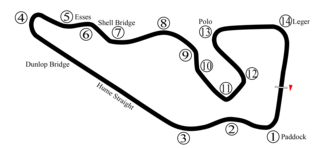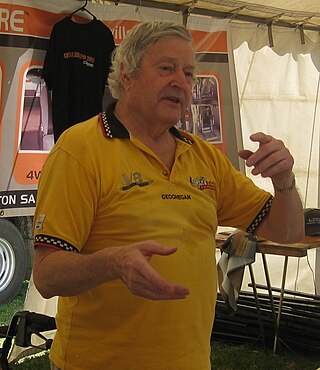The Australian Touring Car Championship (ATCC) is a touring car racing award held in Australia since 1960. The series itself is no longer contested, but the title lives on, with the winner of the Repco Supercars Championship awarded the trophy and title of Australian Touring Car Champion.
Allan George MoffatOBE is a Canadian-born Australian racing driver known for his four championships in the Australian Touring Car Championship, six wins in the Sandown 500 and his four wins in the Bathurst 500/1000. Moffat was inducted into the V8 Supercars Hall of Fame in 1999.
The 1969 Australian Touring Car Championship was a CAMS-sanctioned Australian motor racing title open to Group C Improved Production Touring Cars and Group E Series Production Touring Cars. The championship, which began at Calder Raceway on 23 March and ended at Symmons Plains Raceway on 16 November, was contested over a five heat series. It was the tenth running of the Australian Touring Car Championship and the first to be contested over a series of heats rather than as a single race.
The 1970 Australian Touring Car Championship was a CAMS-sanctioned motor racing title for drivers of Group C Improved Production Touring Cars and Group E Series Production Touring Cars. The title, which was the 11th Australian Touring Car Championship, began at Calder Park Raceway on 22 March 1970 and ended at Symmons Plains Raceway on 15 November after seven heats.
The 1971 Australian Touring Car Championship was a CAMS-sanctioned motor racing title for drivers of Group C Improved Production Touring Cars and Group E Series Production Touring Cars. The title, which was the 12th running of the Australian Touring Car Championship, began at Symmons Plains Raceway on 1 March 1971 and ended at Oran Park Raceway on 8 August after seven heats.
Ian Anthony "Pete" Geoghegan, was an Australian race car driver, known for a quick wit and natural driving skills. Sometimes referred to as "Pete" Geoghegan, he was one of the iconic characters of the 1960s and 1970s Australian motor racing scene. His older brother Leo was also an accomplished driver and the brothers often shared a car in endurance events.
The Ford works team was the unofficial name for an Australian motor racing team which was supported by the Ford Motor Company of Australia. The team was formed in 1962 and was disbanded when Ford Australia withdrew from motor racing at the end of 1973. Drivers for the works team included Allan Moffat, Fred Gibson, Harry Firth, Bob Jane, Barry Seton, Bruce McPhee, John French, Ian Geoghegan and his brother Leo Geoghegan. Ford Australia also supported a factory rally team in Australia from 1977 to 1980.

The 1980 Hardie-Ferodo 1000 was the 21st running of the Bathurst 1000 touring car race. It was held on 5 October 1980 at the Mount Panorama Circuit just outside Bathurst in New South Wales, Australia. The race was open to cars eligible under the locally developed CAMS Group C Touring Car regulations with four engine capacity based classes.

The 1969 Hardie-Ferodo 500 was the tenth running of the Bathurst 500 production car race. It was held on 5 October 1969 at the Mount Panorama Circuit just outside Bathurst in New South Wales, Australia. Cars competed in five classes based on purchase price of the vehicle.

The 1967 Gallaher 500 was a motor race for Production Saloon Cars held at the Mount Panorama Circuit just outside Bathurst in New South Wales, Australia on 1 October 1967. The race, which was the eighth running of the Phillip Island 500/Bathurst 500, was organised by the Australian Racing Drivers Club Ltd and promoted by Gallaher International (Aust) Ltd.

The 1964 Australian Touring Car Championship was a CAMS sanctioned national motor racing title for drivers of Appendix J Touring Cars and Group E Series Production Touring Cars. The championship, which was the fifth Australian Touring Car Championship, was contested over a single race staged at the Lakeside International Raceway in Queensland, Australia, on 26 July 1964. The race was won by Ian Geoghegan, the first of his five Australian Touring Car Championship titles. Geoghegan drove a Ford Cortina GT in what was the first Australian Touring Car Championship victory for a Ford driver and the first time that a Jaguar driver did not win the title.
Norman Edward Beechey is a retired Australian race car driver, who was given the nickname "Stormin Norman" by his fans. To some, he was the closest thing Holden had to a star racing driver, before Peter Brock. Beechey competed in the Australian Touring Car Championship from 1963 to 1972 winning the title in 1965 driving a Ford Mustang and in 1970 at the wheel of a Holden Monaro. Along the way, he achieved seven round wins, and one pole position. His championship win in 1970 was the first victory by a Holden driver in the Australian Touring Car Championship.

The 1964 Armstrong 500 was a production car race held on 4 October 1964 at the Mount Panorama Circuit just outside Bathurst in New South Wales, Australia. The 500 mile race was open to Australian built production sedans of which 100 examples had been registered. It was the fifth Armstrong 500 and the second to be held at Bathurst although it is commonly referred to as the fifth "Bathurst 500".
The 1965 Australian Touring Car Championship was a CAMS sanctioned motor racing title open to Group C Improved Production Touring Cars. It was contested over a single 40-lap race staged at Sandown Raceway in Melbourne, Victoria, Australia on 11 April 1965. It was the sixth Australian Touring Car Championship title to be awarded and the first to be contested by cars complying with Group C regulations.

The 1967 Australian Touring Car Championship was a CAMS sanctioned national motor racing title open to Group C Improved Production Touring Cars. It was contested over a single race, staged at the Lakeside Circuit in Queensland, Australia on 30 July 1967. The title, which was the eighth Australian Touring Car Championship, was won by Ian Geoghegan, driving a Ford Mustang.

The 1968 Australian Touring Car Championship was a CAMS sanctioned Australian motor racing title open to Group C Improved Production Touring Cars. It was contested over a single race staged at the Warwick Farm circuit in New South Wales, Australia on 8 September 1968. The title, which was the ninth Australian Touring Car Championship, was won by Ian Geoghegan driving a Ford Mustang. It was the final Australian Touring Car Championship held as a single race, with the title being contested over a series of races from 1969 onwards.
The 1972 Australian Touring Car Championship was a CAMS sanctioned national motor racing title open to Group C Improved Production Touring Cars and Group E Series Production Touring Cars. The championship, which was the 13th running of the Australian Touring Car Championship, began at Symmons Plains and ended at Oran Park after eight rounds.
John French is an Australian retired racing driver.

Leo Francis Geoghegan was an Australian racing driver. He was the elder of two sons of former New South Wales car dealer Tom Geoghegan, both of whom become dominant names in Australian motor racing in the 1960s. While his younger brother Ian "Pete" Geoghegan had much of his success in touring car racing, winning five Australian Touring Car Championships, Leo spent most of his racing career in open wheel racing cars.

The Bathurst 500 was a Supercars Championship motor racing event that has been on occasion, with the most recent iteration for the 2024 season at Mount Panorama Circuit in Bathurst, New South Wales, Australia.





